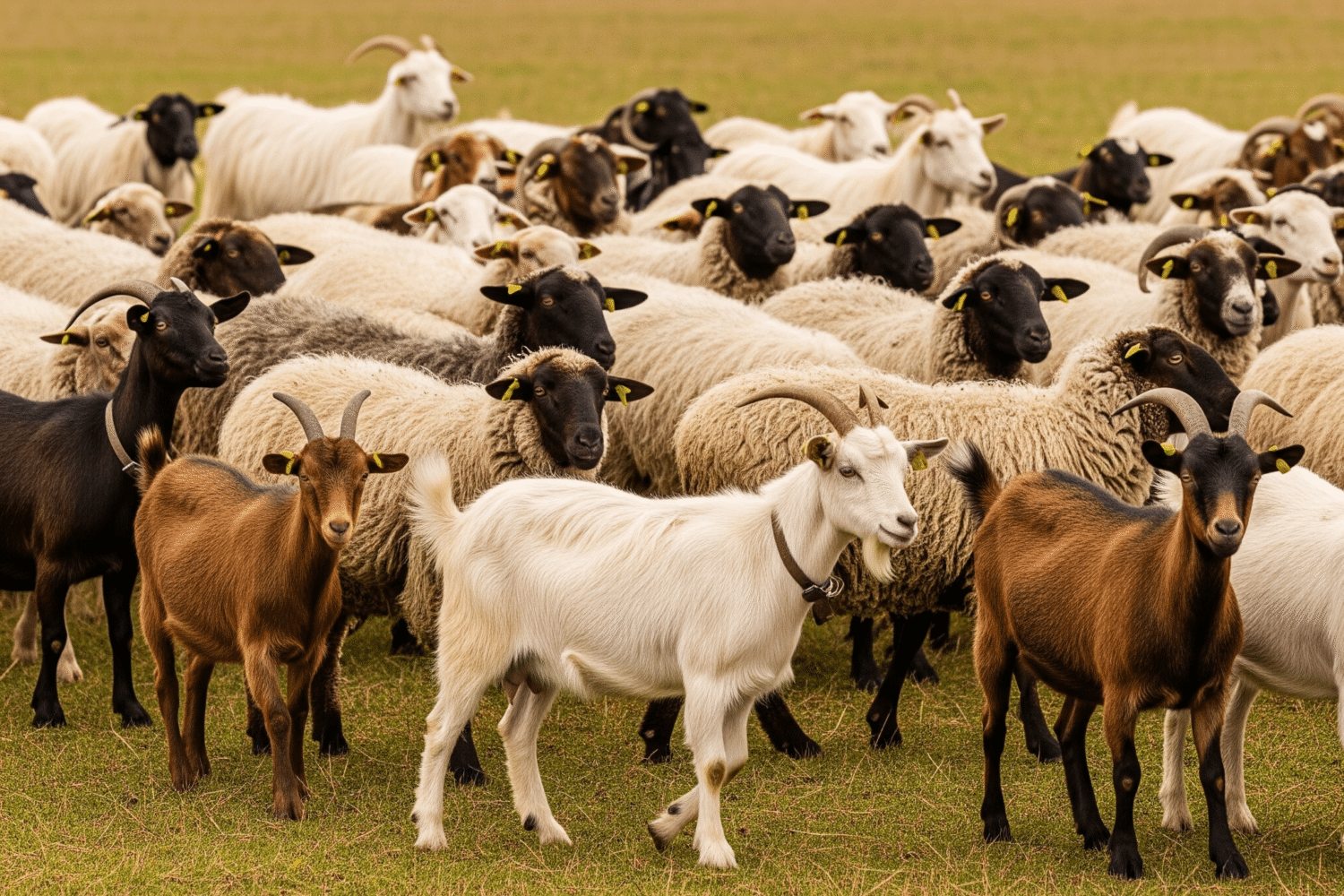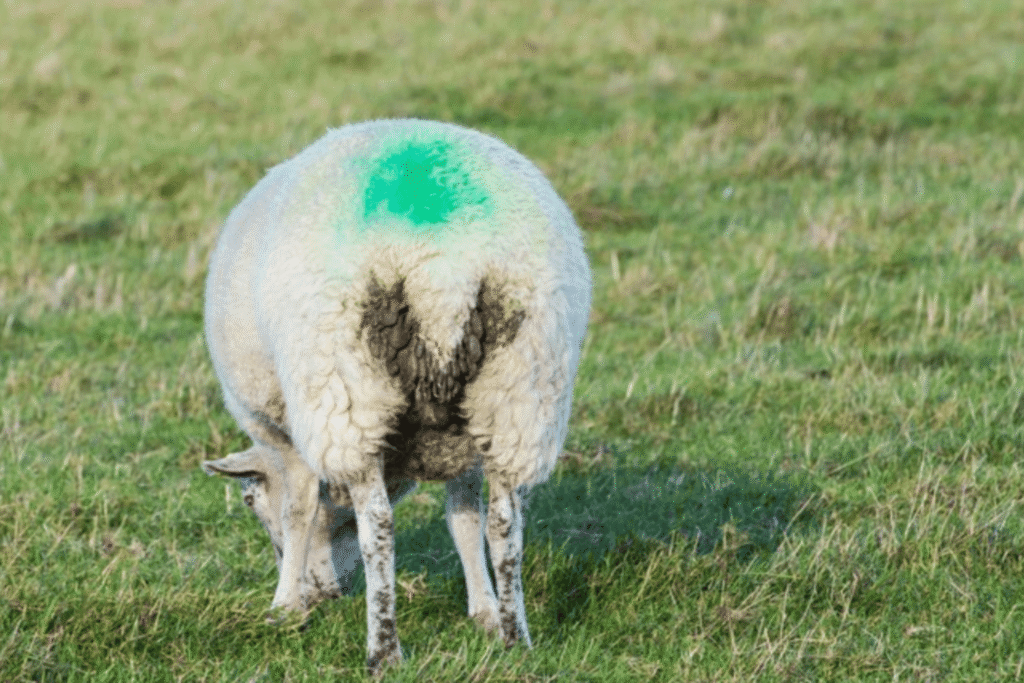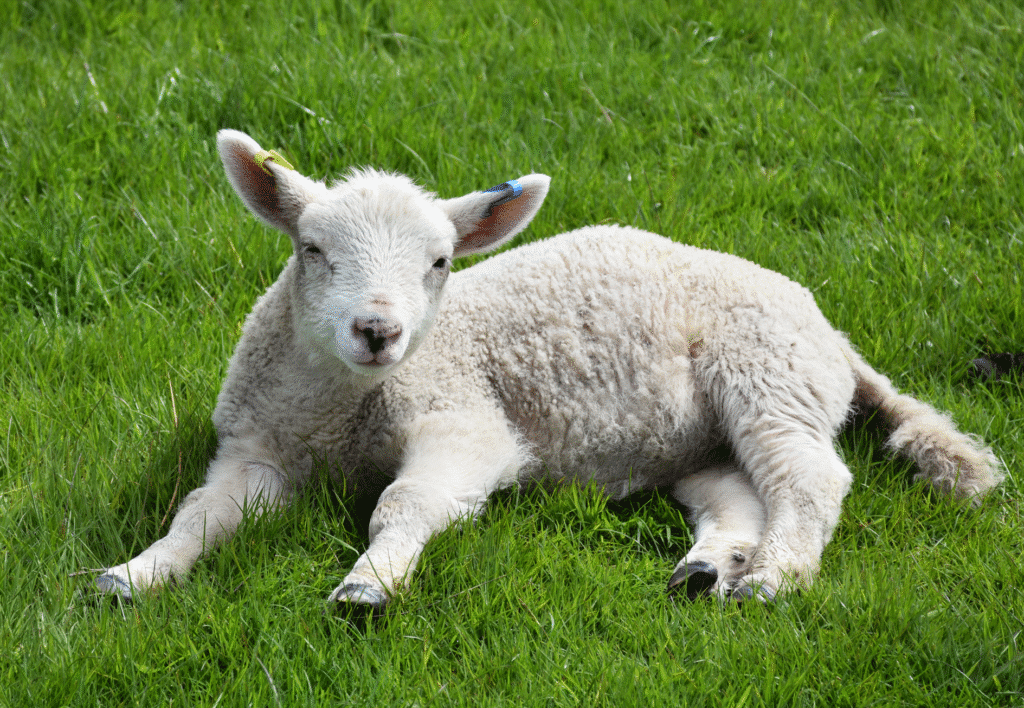Having a herd of sheep and goats means you have to protect them from various diseases. These illness of goat and sheep can cause serious problems, but knowing about them can help you avoid big losses and allow you to treat them or call your veterinary doctor in time. To understand the common diseases that affect goats and sheep, you’re in the right place. Goats and sheep both belong to the group of animals called ruminants. This means they have a similar digestive system with a four-chambered stomach. Because of this similarity, they can also suffer from many of the same diseases.
In many parts of Europe and Asia, people often keep mixed herds of both goats and sheep. Some diseases can even spread from one species to the other. Here, we will discuss some common diseases in sheep and goats that can cause breathing problems, infections, pain, and other serious health issues.
Pneumonia in Goats and Sheep: A Common Respiratory Disease
Pneumonia is a common disease in goat and sheep, characterized by inflammation of the lungs and bronchioles. It occurs when either infectious or non-infectious agents cause the lung tissues of goats and sheep to become inflamed. Among the most common causes are the bacteria Pasteurella multocida and Mannheimia haemolytica, both frequently found in the upper respiratory tracts of healthy animals. Under stressful conditions or due to poor management, these bacteria can trigger acute outbreaks, making pneumonia one of the most serious and common diseases in goats and sheep.
The onset of pneumonia is often linked to factors such as transportation stress, overcrowded housing, sudden weather changes, viral infections, lung parasites, and prior bacterial infections. These elements weaken the immune defenses of goats and sheep, increasing vulnerability to infections caused by P. multocida and M. haemolytica. Symptoms of this Pneumonia in sheep and goats include high fever (104°F–106°F), painful moist coughing, labored breathing, nasal and ocular discharge mixed with mucus and pus, crackling lung sounds, appetite loss, and lethargy. Young animals may suffer high mortality despite low morbidity in outbreaks.
Effective treatment of pneumonia in goats and sheep requires prompt antibiotic therapy. Common veterinary-prescribed antibiotics for pneumonia in sheep and goad include penicillin, ampicillin, tetracycline, oxytetracycline, tylosin, florfenicol, and ceftiofur. Isolating infected animals in a dry, well-ventilated area is essential to prevent the spread of this Pneumonia in goats and sheep. Preventative strategies such as vaccination, reducing animal stress, and maintaining proper herd management practices play a crucial role in controlling respiratory diseases like pneumonia, which is one of the most common diseases in sheep and goats worldwide.
Caprine Arthritis and Encephalitis (CAE) in Goat and Sheep
Caprine Arthritis and Encephalitis (CAE) is a chronic viral disease caused by the small ruminant lentivirus (SRLV), a member of the Retroviridae family. It mostly affects dairy goats but can also appear in meat goats and sheep under certain conditions. CAE spreads mainly through the colostrum or milk of infected does. Kids that consume these fluids are at high risk. 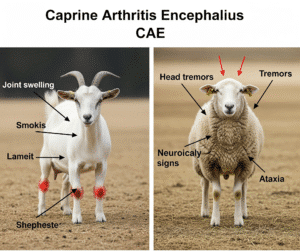
Caprine Arthritis and Encephalitis (CAE) disease progresses slowly and often goes unnoticed for months or even years. Common symptoms in Caprine Arthritis and Encephalitis (CAE) in sheep and goat include joint swelling, stiffness, lameness (especially in the carpal joints), weight loss, poor hair condition, hard udder (mastitis), and in some cases, difficulty breathing due to pneumonia. In young kids (typically between 2–6 months old), the virus can cause nervous system issues such as weakness, tremors, ataxia (loss of balance), and eventual paralysis.
CAE has no cure. Supportive care like pain relief (e.g., anti-inflammatory medication), extra bedding, and proper nutrition can help improve comfort. However, infected animals remain carriers for life and may need to be euthanized if symptoms become severe.
Diagnosis is usually based on herd history and clinical signs. To confirm infection, vets may run blood tests such as ELISA or AGID. However, early test results in young kids might reflect maternal antibodies from colostrum rather than active infection.
To control the spread of CAE, consider the following management practices:
- Remove or isolate infected animals from your herd
- Avoid pooling colostrum or milk from different does
- Feed kids with heat-treated colostrum and pasteurized milk
- Test your herd regularly (twice a year is ideal, especially for high-risk herds)
- Quarantine and test new animals before adding them to the group
- Always disinfect tools and avoid reusing needles
Although CAE is common in many parts of the world—especially in commercial dairy herds—good biosecurity and careful herd management can significantly reduce its impact.
Pregnancy Toxemia (Twin Lamb Disease, Pregnancy Ketosis in Goat and sheep)
Pregnancy Toxemia (Twin Lamb Disease, Pregnancy Ketosis) is a common and serious metabolic disorder that affects pregnant sheep and goats—usually in the last few weeks of gestation. It mainly occurs in animals carrying twins or triplets and happens when their energy needs are higher than what they’re eating. This imbalance forces the body to break down fat for fuel.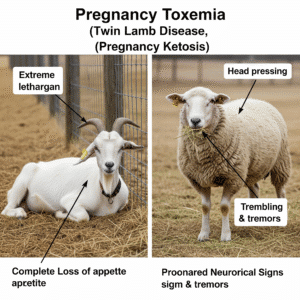
Pregnancy Toxemia is more common in very thin or very fat animals, and also in flocks where feed quality is poor or animals have other health problems like footrot or dental issues that stop them from eating properly. Stress from bad weather, transport, or shearing can make things worse.
Early treatment of Pregnancy Toxemia includes giving energy-rich supplements like propylene glycol, electrolytes, and sometimes inducing labor to relieve the burden of pregnancy. If not caught early, recovery is difficult and many animals won’t survive.
Prevention is all about feeding well during the last 6 weeks of pregnancy—especially for animals carrying more than one fetus. It helps to monitor body condition, separate thin or young animals, and make sure they get enough space and access to feed. Blood tests for ketone levels (BHB) can also help spot trouble early before signs appear.
Bluetongue in Sheep and Goat
Bluetongue is a non-contagious viral disease that mainly affects sheep, with goats often showing milder or no symptoms. It is caused by the bluetongue virus (BTV), which is transmitted by biting midges of the Culicoides species. 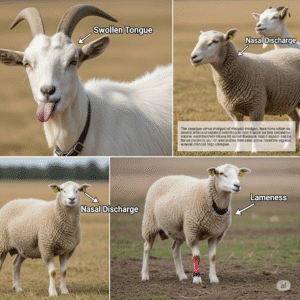
Bluetongue symptoms in sheep include fever, facial swelling, nasal discharge, drooling, lameness, and in severe cases, a swollen blue-colored tongue — which gives the disease its name. Goats tend to have mild or subclinical infections. Diagnosis is based on clinical signs and confirmed through laboratory tests such as PCR or ELISA. Postmortem findings in severe cases may show hemorrhages in internal organs and inflammation in the mouth and hooves.
There is no specific antiviral treatment for bluetongue. Supportive care, including rest, clean water, and soft food, can help affected animals recover. Preventive measures focus on vector control (such as using insect repellents and reducing exposure to biting midges) and vaccination in endemic regions. Inactivated vaccines are preferred, especially in areas where multiple bluetongue serotypes are present, to avoid complications from live vaccine strains.
Sheep and Goat Pox
Sheep and Goat Pox are severe, contagious viral diseases that affect sheep and goats, primarily in parts of southeastern Europe, Africa, and Asia. These illnesses are caused by closely related capripoxviruses, which also share similarities with the virus responsible for lumpy skin disease in cattle. While the viruses are host-specific in some regions, certain strains can infect both species. Typically, sheeppox presents more severely than goatpox, though the clinical signs are generally similar. The disease spreads through direct contact with infected animals or their lesions, possibly via airborne transmission, or mechanically through biting insects.
After an incubation period of 4–8 days in sheep and 5–14 days in goats, animals develop fever and show varying degrees of systemic illness. Swelling of the eyelids and mucopurulent nasal discharge are common early symptoms. Distinct skin lesions soon follow, especially on the muzzle, ears, and hairless areas. These lesions begin as red patches and evolve into raised plaques with inflamed borders, due to localized inflammation and skin thickening. Eventually, the lesions form dark, crusted scabs that leave behind star-shaped, hairless scars once healed. In severe cases, internal organs such as the lungs may also be affected, although some animals—depending on species or breed—may experience only mild or no symptoms.
Diagnosing sheeppox and goatpox is typically based on the characteristic skin lesions. But, it’s important to distinguish them from contagious ecthyma (orf), a milder disease that causes crusty sores mainly around the mouth. While orf is self-limiting and not usually life-threatening, sheeppox and goatpox can result in significant economic losses due to high mortality, especially in young or vulnerable animals. Because of their contagious nature and potential severity, early detection and biosecurity measures are critical to controlling outbreaks in affected regions.
Some more Common Disease in Sheep and Goat
Enterotoxemia (Overeating Disease)
Enterotoxemia (Overeating Disease) is caused by toxins produced by Clostridium perfringens bacteria, primarily affecting young lambs and kids. Symptoms include loss of appetite, abdominal pain, diarrhea, fever, lethargy, and sudden death. Treatment involves antitoxins, antibiotics like penicillin, anti-bloating agents, and supportive care, while vaccination remains a highly effective preventive strategy.
Foot Rot and Foot Scald
Foot Rot and Foot Scald are contagious infections affecting the hooves of sheep and goats. Foot rot results from Dichelobacter nodosus and Fusobacterium necrophorum bacteria, causing lameness, foul odor, pus, and hoof deformity. Whereas foot scald is an inflammation between the toes caused by F. necrophorum. Control includes isolation, hoof trimming, footbaths, antibiotics, and thorough cleaning; sheep can be vaccinated, but no FDA-approved vaccine exists for goats.
Keratoconjunctivitis (Pinkeye)
Keratoconjunctivitis (Pinkeye) in goats and sheep is mainly caused by Mycoplasma conjunctivae and Chlamydia species, often triggered by stress or animal movements. Affected animals show reddened, swollen eyes, squinting, discharge, cloudiness, and in severe cases, ulcerations. Prompt separation, eye cleansing with sterile saline, and veterinarian-prescribed antibiotics are crucial for treatment.
Listeriosis (Circling Disease)
Listeriosis (Circling Disease) is a serious neurological disease caused by Listeria monocytogenes, often contracted from spoiled feed. Infected animals exhibit circling behavior, seizures, facial paralysis, excessive salivation, difficulty swallowing, and may die if untreated. Management includes antibiotics, anti-inflammatory drugs, fluid therapy, and prevention by discarding contaminated feed.
Mycoplasmosis (Contagious Agalactiae)
Mycoplasmosis (Contagious Agalactiae) is caused by several Mycoplasma species, spreading through direct contact, contaminated equipment, or suckling. Symptoms include mastitis, arthritis, pinkeye, diarrhea, respiratory distress, and abortions. Treatment is challenging, involving supportive care, antibiotics, culling infected animals, and feeding kids pasteurized milk to prevent infection.
Polioencephalomalacia (Thiamine Deficiency)
Polioencephalomalacia (Thiamine Deficiency) is a metabolic disorder caused by thiamine deficiency or factors like sudden diet changes or prolonged medication. Symptoms include seizures, lethargy, muscle tremors, blindness, teeth grinding, and death if untreated. Veterinary intervention with intravenous thiamine is essential for recovery.
Scrapie
Scrapie is a fatal, chronic neurological disease in sheep (and occasionally goats) caused by prions. It spreads through contact with infected animals or contaminated pastures and has a long incubation period. Signs include intense itching, wool loss, behavioral changes, incoordination, and convulsions. Diagnosis is confirmed by microscopic brain lesions, and affected carcasses must be condemned to prevent spread.
Frequent Ask Questions
Are goats and sheep related?
Yes, goats and sheep are closely related animals. They both belong to the Bovidae family and the Caprinae subfamily. However, they are different species: goats are Capra aegagrus hircus, while sheep are Ovis aries. Although similar in size and grazing behavior, they have distinct physical and genetic differences.
What is the most common disease in sheep and goats?
The most common disease in both sheep and goats is enterotoxemia, also known as overeating disease or pulpy kidney disease. It is caused by the Clostridium perfringens bacteria and often affects young animals. Sudden death can occur without warning, especially after consuming high-energy feed.
What is the most common disease in goats?
One of the most common diseases in goats is caprine arthritis encephalitis (CAE), a viral infection that causes chronic joint inflammation, lameness, weight loss, and occasionally neurological symptoms. It is spread through bodily fluids and contaminated milk from infected does to kids.
What are the most common parasites in sheep and goats?
The most common parasites in sheep and goats include both internal and external types. Internally, gastrointestinal worms like Haemonchus contortus (barber pole worm), Trichostrongylus, and liver flukes are major concerns. Externally, lice, mites, and ticks can cause irritation, anemia, and skin damage.
What is the viral disease common in sheep?
A common viral disease in sheep is orf, also known as contagious ecthyma. It causes scabby sores around the mouth, nose, and sometimes the udder or hooves. Orf is highly contagious and zoonotic, meaning it can spread to humans.
What is the goat and sheep virus?
Both goats and sheep can be affected by viral diseases such as orf (contagious ecthyma), caprine arthritis encephalitis (in goats), and maedi-visna (in sheep). These viruses often impact the immune system, lungs, joints, and overall productivity.
What is goat disease in humans?
Certain diseases in goats can be transmitted to humans. These zoonotic diseases include brucellosis, Q fever, orf, and leptospirosis. Proper hygiene, protective equipment, and vaccination of herds help prevent transmission to humans.
What is lung worm in sheep and goat?
Lungworm is a parasitic infection caused by nematodes such as Dictyocaulus filaria. It affects the respiratory system of sheep and goats, leading to coughing, labored breathing, and reduced weight gain. Severe infestations can result in pneumonia and death if untreated.
What are the ectoparasites in sheep and goats?
Ectoparasites commonly found in sheep and goats include lice, mites, fleas, ticks, and keds. These pests live on the animal’s skin or fleece and cause irritation, wool damage, skin infections, and anemia. Regular treatment and good management help control infestations.
What parasite kills goats?
Haemonchus contortus, also known as the barber pole worm, is one of the most deadly parasites in goats. It feeds on the blood in the animal’s stomach, causing severe anemia, weakness, and sudden death if left untreated.
What is a common killer in goats?
Enterotoxemia and internal parasite overload, particularly from barber pole worms, are among the leading killers of goats. Pneumonia and CAE can also be fatal if not managed promptly. Proper nutrition, vaccination, and parasite control are critical for prevention.
What is the eye disease in goats?
Pink eye, or infectious keratoconjunctivitis, is a common eye disease in goats. It causes redness, swelling, discharge, and sensitivity to light. It can spread quickly through contact or flies, especially in dusty or crowded conditions.
What is goats lung disease?
Goats can suffer from lung diseases such as pneumonia and CAE-related interstitial pneumonia. Pneumonia is caused by bacterial or viral infections, leading to fever, coughing, nasal discharge, and breathing difficulty. It is often triggered by stress, weather changes, or poor ventilation.
What disease kills sheep?
Sheep are commonly affected by diseases such as enterotoxemia, pneumonia, and footrot. Enterotoxemia, caused by Clostridium perfringens, and severe internal parasitism are leading causes of sudden death in flocks.
How to treat pink eye in goats?
Treating pink eye in goats involves isolating the infected animal and applying antibiotic eye ointments or drops as prescribed by a veterinarian. Keeping the environment clean and reducing fly exposure are also important. Severe cases may require injectable antibiotics.
What is the difference between a goat and a sheep?
Goats and sheep differ in appearance, behavior, and physiology. Goats typically have short hair, upright tails, and prefer browsing on shrubs, while sheep have woolly coats, downward tails, and prefer grazing on grass. Male goats often have beards and horns that differ in shape from those of sheep. They also differ in vocalization, flocking instincts, and domestication history.

